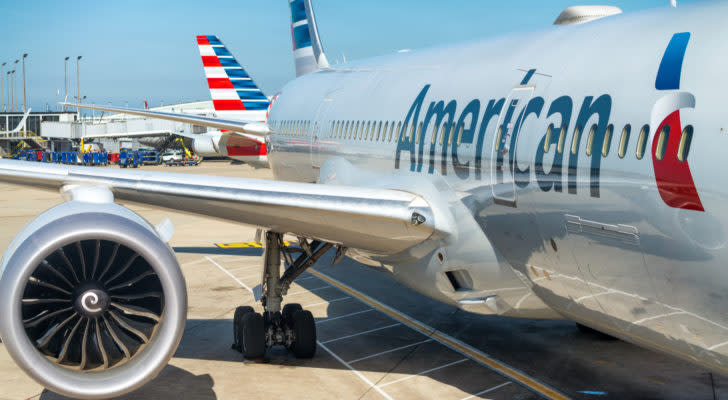American Airlines Stock Is Still Too Risky Despite Supposed Resurgence
A number of industries have been absolutely pummeled by the novel coronavirus pandemic. With the exception of cruise lines, few have taken it on the chin the way airlines have. International and domestic air travel has plummeted, and the future of air travel looks far from promising. American Airlines (NASDAQ:AAL) shares have dropped by as much as 70% since February. That would make them tempting to buy on the cheap if there was a clear path to recovery. But there isn’t. Even after hobbling together a week of 9% gains, AAL stock is still way too risky.

Source: GagliardiPhotography / Shutterstock.com
Airlines and cruise lines are in a similar boat at the moment (pardon the pun). Both saw their business — carrying passengers — gutted by the novel coronavirus pandemic. Companies in both sectors have seen their stock value collapse. Both are hanging by a thread, hoping for a future return to normalcy.
The vultures are circling both sectors. On May 5, Norwegian Cruise Lines (NYSE:NCLH) publicly raised the possibility of bankruptcy. Globally, several airlines have already declared bankruptcy as a result of the pandemic, including Flybe and Virgin Australia.
InvestorPlace - Stock Market News, Stock Advice & Trading Tips
U.S. airlines have a huge problem that the cruise lines don’t. While cruise lines are docking their ships to wait out the storm, U.S. airlines must continue flying. Even with passenger volume down by as much as 95% compared to pre-pandemic levels. Part of their fleet can be grounded, but service must continue, and that means huge operational costs continue. American Airlines has reportedly been burning through $70 million a day since the crisis began.
Is it any wonder AAL stock is sitting at lows not seen since 2013?
What About Government Bailouts?
Cruise lines were ineligible for government funding under the CARES Act. Incorporating offshore brought them big tax advantages, but cost them any shot at receiving assistance.
Airlines did get money. Of the $2 trillion in funding, $58 billion was earmarked for keeping the airlines afloat. American Airlines received a $4.1 billion grant and $1.7 billion in loans. But the assistance came with big catches. Companies accepting CARES funding are banned from share buybacks for the term of the loan plus one year, and can’t issue dividends. In addition, the government funds are aimed at keeping staff employed. And to be eligible, airlines must keep flying domestically, which brings us back to those killer operating costs.
The ‘New Normal’ for Air Travel Doesn’t Look Pretty
American Airlines is taking measures to reduce risk, and to reassure passengers that it is safe to fly. In May, it began distributing face masks and sanitizing wipes to passengers. Flight attendants were required to wear face masks. Food and beverage service was suspended on domestic flights. Its planes have been undergoing thorough cleaning after every flight, including disinfecting any surfaces passengers may have touched. Social distancing is enforced in airports, at ticket counters and during boarding.
All of these measures mean added cost. Some are intrusive enough to have the opposite effect and discourage some passengers from flying. In addition, there is pressure for additional safety measures ranging from passenger temperature checks to flying planes with seats empty to provide distance between passengers.
Until an effective COVID-19 vaccine is brought to market and the pandemic brought under control, none of this may be enough. Robert Reich, a noted University of California at Berkeley professor told CNBC:
“Many people are not going to feel safe going back to crowded airplanes … until they see that the number of new deaths from the virus has gone down to almost none in their region, or until there is a vaccine or much better ways of tracing and isolating who has it.”
It’s not just flying for pleasure that faces a bleak future.
Business travel is also at risk. Companies that instituted work from home policies and travel bans as the coronavirus hit the U.S. are discovering they saved a lot of money. As a result, the future of airlines may include significantly less business travel, as companies adopt cost-effective alternatives like video conferencing instead.
Bottom Line on AAL Stock
Touching $10, AAL stock is trading slightly above its $9.04 close on May 15. That was its low point for 2020, by the way. Even during the worst of the March market selloff, the stock was performing better. The current price combined with a 9% gain over the past week might convince you now is the time to scoop up American Airlines shares.
However, doing so assumes things won’t get worse for American. Based on the continued havoc being wreaked by the coronavirus and the bleak prospects for air travel under the “new normal,” I certainly wouldn’t make that bet.
Louis Navellier had an unconventional start, as a grad student who accidentally built a market-beating stock system — with returns rivaling even Warren Buffett. In his latest feat, Louis discovered the “Master Key” to profiting from the biggest tech revolution of this (or any) generation. Louis Navellier may hold some of the aforementioned securities in one or more of his newsletters.
More From InvestorPlace
The post American Airlines Stock Is Still Too Risky Despite Supposed Resurgence appeared first on InvestorPlace.
